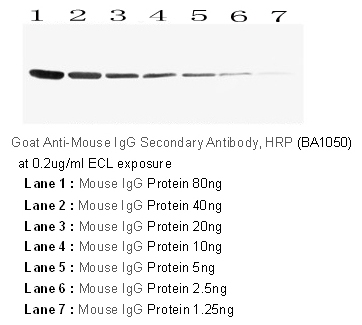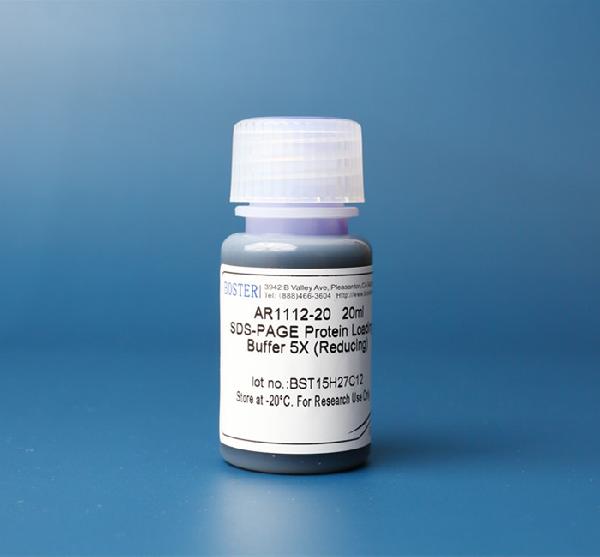Product Info Summary
| SKU: | BA1050 |
|---|---|
| Size: | 0.5ml |
| Reactive Species: | Mouse |
| Host: | Goat |
| Application: | ELISA, WB |
Customers Who Bought This Also Bought
Product info
Product Overview
| Product Name | HRP Conjugated AffiniPure Goat Anti-Mouse IgG (H+L) |
|---|---|
| Synonyms | HRP-conjugated goat anti-mouse IgG |
| Description | HRP Conjugated Goat Anti-mouse IgG (H+L) (gamma-chain specific) secondary antibody This HRP conjugated antibody is specific for mouse IgG and shows no cross-reactivity with human/bovine/rabbit IgG. |
| Reagent Type | Secondary antibody, reporter enzyme labeled |
| Label | HRP (Horseradish Peroxidase) |
| Host | Goat |
| Target Species | Mouse |
| Antibody Class | IgG |
| Clonality | Polyclonal |
| Immunogen | Mouse IgG (whole molecular) |
| Preparation | Affinity purified from rabbit antiserum |
| Specificyity | This HRP conjugated antibody is specific for mouse IgG and shows no cross-reactivity with human/bovine/rabbit IgG. |
| Form Supplied | Concentrated, Liquid |
| Formulation | 0.5 mg of HRP conjugated specific antibody
0.01 M PBS (pH7.4) 50% glycerol |
| Pack Size | 0.5 ml |
| Concentration | 1mg/ml |
| Application | ELISA*, WB* *Our Boster Guarantee covers the use of this product in the above marked tested applications. |
| Storage | At -20˚C for one year from date of receipt. Avoid repeated freezing and thawing. |
| Precautions | FOR RESEARCH USE ONLY. NOT FOR DIAGNOSTIC OR CLINICAL USE |
Assay Information
| Sample Type | SDS-PAGE separated-, membrane-immobilized-, mouse primary-antibody-probed proteins from cell/tissue lysates |
|---|---|
| Assay Type | Immunoassay |
| Assay Purpose | Protein detection/quantification |
| Technique | Immunodetection of target antibody with HRP reporter enzyme |
| Equipment Needed | WB/ELISA instrumentation; X-ray film cassette or a charge-coupled device (CCD) imager; Spectrophotometer |
| Compatibility with Reagents | Incompatible with sodium azide and metals incompatible with high phosphate concentrations |
Main Advantages
| Specific | High signal-to-noise ratio |
|---|---|
| Sensitive | Detects low-abundant targets due to an optimal number of HRP molecules per antibody |
| High Signal Amplification | Multiple secondary antibodies can bind to a single primary antibody;Secondary antibodies Fc regions provide further binding locations for biotin, or enable the use of ABC and SABC |
| Fast | Generates strong signals in a relatively short time span |
| Quantifieable | Allows quantification of detected signal |
| Easy to Use | Supplied in a workable liquid format |
| Flexible | HRP: compatible with chromogenic, fluorogenic and chemiluminescent substrates; |
| Convenient | HRP’s small size: no interference with the primary/secondary antibody interaction; no steric hindrance to antibody/antigen complexes |
Background
Most commonly, secondary antibodies are generated by immunizing the host animal with a pooled population of immunoglobulins from the target species. The host antiserum is then purified through immunoaffinity chromatography to remove all host serum proteins, except the specific antibody of interest. Purified secondary antibodies are further solid phase adsorbed with other species serum proteins to minimize cross-reactivity in tissue or cell preparations, and are then modified with antibody fragmentation, label conjugation, etc., to generate highly specific reagents. Secondary antibodies can be conjugated to a large number of labels, including enzymes, biotin, and fluorescent dyes/proteins. Here, the antibody provides the specificity to locate the protein of interest, and the label generates a detectable signal. The label of choice depends upon the experimental application.
Horseradish peroxidase (HRP) is extensively used for labeling secondary antibodies in ELISA, western blot, dot blot and immunohistochemistry. The HRP enzyme is made visible using a substrate that, when oxidized by HRP in the presence of hydrogen peroxide as an oxidizing agent, yields a characteristic change that is detectable by specific detection methods. The substrates commonly used with HRP fall into different categories including chromogenic, fluorogenic, and chemiluminescent substrates depending on whether they produce a colored, fluorimetric or luminescent derivative respectively. The intensity of the signal is proportional to peroxidase activity and is a measure of the number of enzyme molecules reacting, hence of the amount of recognized primary antibodies, and thus of the amount of target antigen.
Product Images
Assay Dilutions Recommendation
The recommendations below provide a starting point for assay optimization. Actual working concentration varies and should be decided by the user.
Western Blotting: 0.1-0.2μg/ml (ECLdetection)
Western Blotting: 0.7-3.3μg/ml (DAB detection)
ELISA: 0.05-0.5μg/ml (TMB detection)
Validation Images & Assay Conditions

Click image to see more details
Specific Publications For BA1050
Hello CJ!
BA1050 has been cited in 998 publications:
*The publications in this section are manually curated by our staff scientists. They may differ from Bioz's machine gathered results. Both are accurate. If you find a publication citing this product but is missing from this list, please let us know we will issue you a thank-you coupon.
Morphologic and histopathologic change of sodium iodate-induced retinal degeneration in adult rats
Hypoxia promotes epithelial-mesenchymal transition of hepatocellular carcinoma cells via inducing Twist1 expression.
MicroRNA-9 is a ponderable index for the prognosis of human hepatocellular carcinoma
Genes associated with sodium fluoride-induced human osteoblast apoptosis
Atorvastatin ameliorates myocardial ischemia/reperfusion injury through attenuation of endoplasmic reticulum stress-induced apoptosis
Overexpression of 15-lipoxygenase-1 in oxygen-induced ischemic retinopathy inhibits retinal neovascularization via downregulation of vascular endothelial growth factor-A expression
miR-375 enhances palmitate-induced lipoapoptosis in insulin-secreting NIT-1 cells by repressing myotrophin (V1) protein expression
Study of Sequential Histopathologic Changes, Apoptosis, and Cell Proliferation in Rabbit Livers After High‐Intensity Focused Ultrasound Ablation
Serum containing Buyang Huanwu decoction prevents age-associated migration and invasion of human vascular smooth muscle cells by up regulating SIRT1 expression
Lysyl hydroxylase 3 increases collagen deposition and promotes pulmonary fibrosis by activating TGFβ1/Smad3 and Wnt/β-catenin pathways
Customer Reviews
Have you used HRP Conjugated AffiniPure Goat Anti-Mouse IgG (H+L)?
Submit a review and receive an Amazon gift card.
- $30 for a review with an image
0 Reviews For HRP Conjugated AffiniPure Goat Anti-Mouse IgG (H+L)
Customer Q&As
Have a question?
Find answers in Q&As, reviews.
Can't find your answer?
Submit your question
1 Customer Q&As for HRP Conjugated AffiniPure Goat Anti-Mouse IgG (H+L)
Question
Is this product suitable for IHC? Keyword: application, Immunohistochemistry
Verified Customer
Verified customer
Asked: 2014-12-26
Answer
Please beware that this product is not suitable for IHC. Small package of secondaries (0.5 ml) can do 15-75 slides and 1ml can do 30-150 slides. The difference is in the way customer uses the reagent.
Boster Scientific Support
Answered: 2014-12-26






